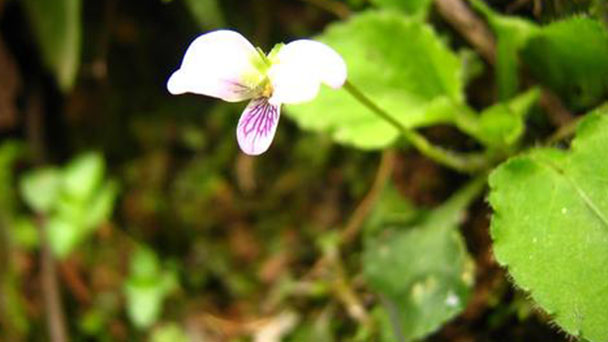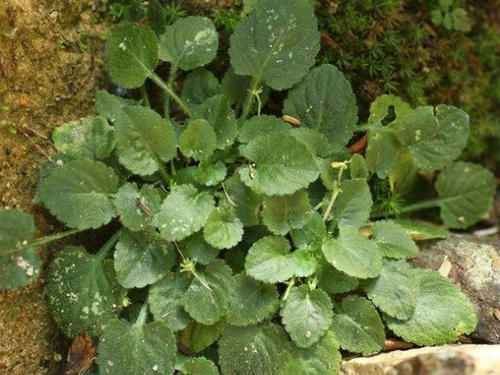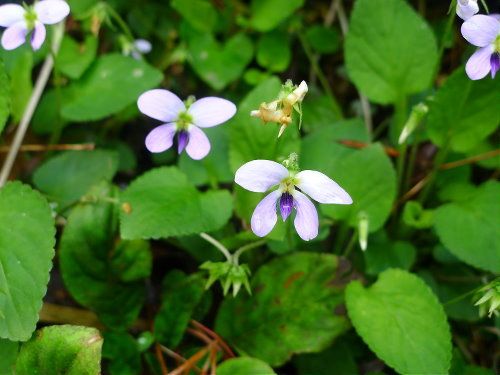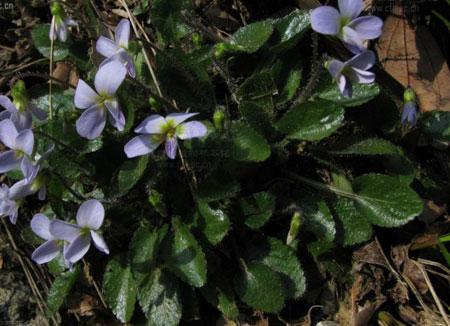Viola diffusa profile
Written by Maggie
Mar 09 2021

Viola diffusa is an annual herb, all is strigose or white pubescent, or nearly glabrous, fluorescence gives birth to creeping branches on the ground. Viola diffusa stolon branches apex is with rosette - shaped leaf clusters, usually with adventitious roots.
Viola diffusa picture

Morphological characteristics of the Viola diffusa
Branches and roots
Viola diffusa is an annual herb, all hispid or white pubescent, or nearly glabrous, flowering gives birth to creeping branches on the ground. Stolon branches apex is with rosette - shaped leaf clusters, usually with adventitious roots. Rhizome is short, with many white fine roots and fibrous roots.
Leaf
Basal leaves of Viola diffusa are numerous, clustered in rosette shape, or alternate on creeping branches; Leaf blade is ovate or ovate-oblong, 1.5 -- 3.5 cm long, 1 -- 2 cm wide, apically obtuse or slightly acute, basally broadly cuneate or truncate, thinly shallowly cordatate, distinctly descending to petiole, margin obtuse toothed and ciliate, both surfaces of young leaves densely white pubescent, then gradually sparse, veins still densely covered with hairs on both sides; Petiole of Viola diffusa is 2-4.5 cm long, conspicuously winged, usually hairy; Stipules base is connate with petiole, 2/3 free, linear-lanceolate, 4 -- 12 mm long, apex acuminate, margin sparsely serrate or sparsely fimbriate.
Flowers
The flowers of Viola diffusa are small, lavender or pale yellow, long pedunculate, born in the axils of basal leaves or creeping branches. Pedicels are slender, 1.5 -- 8.5 cm long, glabrous or pubescent, with a pair of linear bracts at center; Sepals are lanceolate, 4 -- 5.5 mm long, apex acute, base appendage short, terminal rounded or sparsely serrate, margin sparsely lashes; Lateral petals of Viola diffusa are ovate or oblong-obovate, 6-8 mm long, glabrous, lower petals connate ca. 6 mm, markedly shorter than other petals; Spur is very short, only 1.5 mm long, slightly exposed beyond sepal appendages; The dorsal distance of the lower 2 stamens is short and wide, triangular; Ovaries of Viola diffusa are glabrous, styles clavate, slightly geniculate at base, thickening distally, stigma with hypertrophic margin on both sides and posterior, central part slightly raised, anterior with short bill.
Fruit
Capsule of Viola diffusa oblong, ca. 3 mm in diam., ca. 1 cm long, glabrous, apex often with persistent style.
The ecological habits of Viola diffusa
Viola diffusa was born under the mountain forest, the edge of the forest, the grassy slope, the valley side, the rock crevices.Below 2000m above sea level.

Variety classification of Viola Diffusa
Short beard Viola Diffusa (Variation)
var. brevibarbata C. J. Wang in Acta Bot. Yunnan. 13 (3): 264. 1991.
The main difference between this variety and the original variety is that the lateral petals have conspicuous short whiskers at the inside base.2 n = 26.
Hebei, Shaanxi, Gansu (South), Jiangsu, Anhui, Zhejiang, Jiangxi, Fujian, Henan, Hubei, Hunan, Guangdong, Guangxi, Hainan, Sichuan, Guizhou, Yunnan, Xizang.Type specimens were collected from Luxi County, Yunnan Province.
The same use as the original variant.
The distribution area of Viola diffusa
Viola Diffusa is produced in Zhejiang, Taiwan, Sichuan, Yunnan and Xizang.
Viola diffusa is also found in India, Nepal, the Philippines, Malaysia and Japan.
Viola diffusa propagation
Viola diffusa sowing propagation - best sown as soon as it is ripe in containers in a lightly shaded position, Prick out the seedlings into individual pots when they are large enough to handle and plant them out when large enough.
Viola diffusa division propagation works at any time of the year, so long as the plants are kept moist. Small divisions are best potted up until established, larger divisions can be planted directly into their permanent positions.
How to grow and care for Viola diffusa
Viola diffusa is found from the warm temperate regions of southern China to higher elevations in the tropics of southeast Asia, the Philippines and New Guinea. Viola diffusa prefers a cool moist well-drained humus-rich soil in partial or dappled shade and protection from scorching winds. Tolerates sandstone and limestone soils but becomes chlorotic if the pH is too high. Viola diffusa prefers a pH between 6 and 6.5.
All members of this genus have more or less edible leaves and flower buds, though those species with yellow flowers can cause diarrhoea if eaten in large quantities.
Viola diffusa uses
Medicinal use: bitter, cold. Viola diffusa can clear heat and detoxify, detumescence and discharge pus, clear lung and cough. For boils, boils, venomous snake bite, children with long cough, cough, cough, lung carbuncle, red eyes, injuries.
Edible: Viola diffusa can be collected before the budding period of young plants, remove soil, debris, after washing can be cold, fried food, soup, filling, pickling and so on.

Latest Updated
- Benefits of Bugleweed - 7 Science-backed Health Benefits
- Bugleweed Dangers & Side Effects - Is It Poisonous?
- How to Plant Evergreen Trees - What You Should Know
- When to Plant Evergreens - Grow Guide for Evergreen Trees
- 12 Wonderful Evergreen Shrubs for Your Garden
- 12 Popular Evergreen Plants with Pictures for Beginners
- When And How To Prune A Lilac Bush Like a Pro
- How to Grow & Care for Lilac Vine (Hardenbergia Violacea)
- Japanese Lilac Tree (Syringa Reticulata) Care & Propagation Guide
- Shumard Oak Pros and Cons - What to Know
Popular Articles
- Winter maintenance of Antirrhinum Majus
- How to Grow Terminalia Mantaly Tree
- How to Grow and Care for Crossostephium Chinense
- How to grow Antirrhinum Majus in spring
- Peristeria Elata (Dove Orchid) Profile: Info & Care Guide
- Underwatered Snake Plant (Sansevieria Trifasciata) - Signs And How To Fix
- How to Care for Brazilian Jasmine Plant (Mandevilla Sanderi)
- How to Grow & Care for Graptopetalum Purple Delight in Summer
- Rosa Chinensis (China Rose): Plant Growing & Care Tips
- How to Care for Baby Sun Rose (Aptenia Cordifolia)